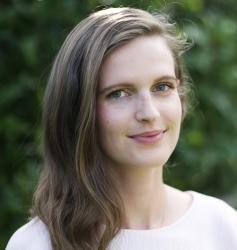Music, films, and books can easily come across as light-hearted entertainment that serve to make us forget our everyday worries. Recording studios, film companies, and publication houses often rigorously control the creative process to meet this ideal and make the material appeal to the largest audience possible—typically, at the cost of the original ideas of the artists behind the works.
For musician MIMRA, however, it is important that artists be true to themselves. She is attracted to music that reflects the artistic vision and freedom of the artist who created it.
“It never ceases to touch me when artists are true to themselves and what they deliver,” she says. “I love the freedom of music, in that sense. It is a structure that you dance around make your own.”
Complete artistic control
MIMRA, aka María Magnúsdóttir, is a Reykjavík-based singer, composer, and producer. She studied music and song throughout her adolescence and released her first album at age 24. She went on to get a Master’s in Popular Music from the Goldsmiths University in London. It was for her Master’s project at this institution that she created her 12 track album, “Sinking Island,” from which the title song, “Sinking Island,” can be found. Without the influence of a recording studio, María was left free to record and produce her songs.
“I recorded the song and album there using Ableton Live, which allowed me to self-produce the content,” she relates. “I was in complete control of the creative process.”
Another way in which the song “Sinking Island” became completely her own is through her unusual use of percussion—to achieve the sound, María clapped on her own body, as well as little objects such as chain keys and pieces of wood. The result is a haunting mixture of taps and beats that beautifully lay the groundwork for the piece.
Shooting the video
The song “Sinking Island” is a reflection on María’s break-up with a long-term partner and represents break-up, death, and rebirth. After the release of the song, María decided to make a music video that would take the song to a new level. Created together with Guðný Rós Þórhallsdóttir, Birta Rán Björgvinsdóttir, and Arnór Einarsson, María trusted that an artistic collaboration would make the material sing.
“I wanted to make a piece of art that would bring together different disciplines,” she states. “And sometimes, adding video to a song can take the material in a different direction and give it a whole new life.”
Reminiscent of Agnes Obel’s song and music video “Riverside,” the video takes the viewer through luminous forests, soaring heights, and ethereal waters. In its artistic expression, the song comes across as the work of a singular vision. “It is a collaborative effort, but the song and the video feel like one—like they belong together,” María reflects.
Artistic Influences
Although María identifies her music as electro-acoustic folk pop, she emphasizes that her music does not easily fit into one genre. “The type of music I make really depends on the music I am listening to at that moment,” she says. “MIMRA is an old Icelandic name that means taking different directions. It’s reminiscent of how I want to go many places with my music. People want to be able to place you. And I don’t mind being labelled but I don’t know if people can label my music.”
With different songs that change in content and style, however, one thing always remains the same: María controls the creative content behind all her music, and she aims for this fact to remain a constant.

Listen to MIMRA’s songs and learn more about her on her website and Spotify.
Buy subscriptions, t-shirts and more from our shop right here!



















